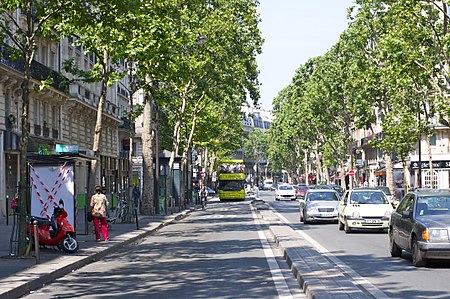The Saint-Germain bombing was a bomb attack carried out on 11 March 1892 in Boulevard Saint-Germain, Paris, by anarchist militants Ravachol, Rosalie Soubère, Joseph Jas-Béala, and Charles Simon. The attack was seen as an act of retribution against Edmond Benoît, the judge presiding over the trial of the accused in the Clichy affair, where three anarchist demonstrators were captured by the police, beaten with sabres, deprived of medical care and water for some time before being judged harshly by Benoît.
After stealing a significant shipment of dynamite, Simon and Ravachol built the bomb together before the four set out for the judge's residence. Soubère carried the bomb under her skirts before handing it to Ravachol, who placed it. It exploded but failed to kill its target, causing no deaths and one injury.
The operation was a strategical failure: the conspirators missed their target, the police were searching for them, and although they failed to prevent the Clichy bombing on 27 March 1892, where Soubère, Béala, and Ravachol attempted to assassinate the prosecutor in the case, Simon was arrested after being denounced by an informant. After the second attack, Ravachol, Jas-Béala, and Soubère were quickly captured and put on trial. Ravachol, whose legal strategy was to take full responsibility for the attack to exonerate his companions, was sentenced to life imprisonment and later to death. Soubère and Jas-Béala were acquitted, while Simon was sentenced to life imprisonment and deported to Cayenne.
Despite this, the attack was a significant tactical success, as it marked the beginning of the Era of Attacks (1892–1894), a violent confrontation between the French state, and later Western states, and anarchists. The attack inspired other anarchist militants such as Auguste Vaillant, Émile Henry or Amédée Pauwels. In this context, terrorism underwent significant transformations. Although the Boulevard Saint-Germain bombing was still based on the traditional form of terrorism, 'tyrannicide', figures inspired by it, such as Émile Henry, used it as a model to develop indiscriminate or mass terrorism, a significant form of terrorism in the 20th and 21st centuries. It also shifted towards a more location-based terrorism instead of targeting individuals each time.
For his defiance towards death and complete dedication to his ideals, Ravachol, in particular, became a mythical figure among anarchist circles, especially among French illegalists, where he was seen as a martyr for the anarchist cause.









